Yankai Chen
LightReasoner: Can Small Language Models Teach Large Language Models Reasoning?
Oct 09, 2025Abstract:Large language models (LLMs) have demonstrated remarkable progress in reasoning, often through supervised fine-tuning (SFT). However, SFT is resource-intensive, relying on large curated datasets, rejection-sampled demonstrations, and uniform optimization across all tokens, even though only a fraction carry meaningful learning value. In this work, we explore a counterintuitive idea: can smaller language models (SLMs) teach larger language models (LLMs) by revealing high-value reasoning moments that reflect the latter's unique strength? We propose LightReasoner, a novel framework that leverages the behavioral divergence between a stronger expert model (LLM) and a weaker amateur model (SLM). LightReasoner operates in two stages: (1) a sampling stage that pinpoints critical reasoning moments and constructs supervision examples capturing the expert's advantage through expert-amateur contrast, and (2) a fine-tuning stage that aligns the expert model with these distilled examples, amplifying its reasoning strengths. Across seven mathematical benchmarks, LightReasoner improves accuracy by up to 28.1%, while reducing time consumption by 90%, sampled problems by 80%, and tuned token usage by 99%, all without relying on ground-truth labels. By turning weaker SLMs into effective teaching signals, LightReasoner offers a scalable and resource-efficient approach for advancing LLM reasoning. Code is available at: https://github.com/HKUDS/LightReasoner
DP-DGAD: A Generalist Dynamic Graph Anomaly Detector with Dynamic Prototypes
Aug 01, 2025Abstract:Dynamic graph anomaly detection (DGAD) is essential for identifying anomalies in evolving graphs across domains such as finance, traffic, and social networks. Recently, generalist graph anomaly detection (GAD) models have shown promising results. They are pretrained on multiple source datasets and generalize across domains. While effective on static graphs, they struggle to capture evolving anomalies in dynamic graphs. Moreover, the continuous emergence of new domains and the lack of labeled data further challenge generalist DGAD. Effective cross-domain DGAD requires both domain-specific and domain-agnostic anomalous patterns. Importantly, these patterns evolve temporally within and across domains. Building on these insights, we propose a DGAD model with Dynamic Prototypes (DP) to capture evolving domain-specific and domain-agnostic patterns. Firstly, DP-DGAD extracts dynamic prototypes, i.e., evolving representations of normal and anomalous patterns, from temporal ego-graphs and stores them in a memory buffer. The buffer is selectively updated to retain general, domain-agnostic patterns while incorporating new domain-specific ones. Then, an anomaly scorer compares incoming data with dynamic prototypes to flag both general and domain-specific anomalies. Finally, DP-DGAD employs confidence-based pseudo-labeling for effective self-supervised adaptation in target domains. Extensive experiments demonstrate state-of-the-art performance across ten real-world datasets from different domains.
From Web Search towards Agentic Deep Research: Incentivizing Search with Reasoning Agents
Jun 23, 2025Abstract:Information retrieval is a cornerstone of modern knowledge acquisition, enabling billions of queries each day across diverse domains. However, traditional keyword-based search engines are increasingly inadequate for handling complex, multi-step information needs. Our position is that Large Language Models (LLMs), endowed with reasoning and agentic capabilities, are ushering in a new paradigm termed Agentic Deep Research. These systems transcend conventional information search techniques by tightly integrating autonomous reasoning, iterative retrieval, and information synthesis into a dynamic feedback loop. We trace the evolution from static web search to interactive, agent-based systems that plan, explore, and learn. We also introduce a test-time scaling law to formalize the impact of computational depth on reasoning and search. Supported by benchmark results and the rise of open-source implementations, we demonstrate that Agentic Deep Research not only significantly outperforms existing approaches, but is also poised to become the dominant paradigm for future information seeking. All the related resources, including industry products, research papers, benchmark datasets, and open-source implementations, are collected for the community in https://github.com/DavidZWZ/Awesome-Deep-Research.
A Call for Collaborative Intelligence: Why Human-Agent Systems Should Precede AI Autonomy
Jun 11, 2025Abstract:Recent improvements in large language models (LLMs) have led many researchers to focus on building fully autonomous AI agents. This position paper questions whether this approach is the right path forward, as these autonomous systems still have problems with reliability, transparency, and understanding the actual requirements of human. We suggest a different approach: LLM-based Human-Agent Systems (LLM-HAS), where AI works with humans rather than replacing them. By keeping human involved to provide guidance, answer questions, and maintain control, these systems can be more trustworthy and adaptable. Looking at examples from healthcare, finance, and software development, we show how human-AI teamwork can handle complex tasks better than AI working alone. We also discuss the challenges of building these collaborative systems and offer practical solutions. This paper argues that progress in AI should not be measured by how independent systems become, but by how well they can work with humans. The most promising future for AI is not in systems that take over human roles, but in those that enhance human capabilities through meaningful partnership.
A Survey on Large Language Model based Human-Agent Systems
May 01, 2025Abstract:Recent advances in large language models (LLMs) have sparked growing interest in building fully autonomous agents. However, fully autonomous LLM-based agents still face significant challenges, including limited reliability due to hallucinations, difficulty in handling complex tasks, and substantial safety and ethical risks, all of which limit their feasibility and trustworthiness in real-world applications. To overcome these limitations, LLM-based human-agent systems (LLM-HAS) incorporate human-provided information, feedback, or control into the agent system to enhance system performance, reliability and safety. This paper provides the first comprehensive and structured survey of LLM-HAS. It clarifies fundamental concepts, systematically presents core components shaping these systems, including environment & profiling, human feedback, interaction types, orchestration and communication, explores emerging applications, and discusses unique challenges and opportunities. By consolidating current knowledge and offering a structured overview, we aim to foster further research and innovation in this rapidly evolving interdisciplinary field. Paper lists and resources are available at https://github.com/HenryPengZou/Awesome-LLM-Based-Human-Agent-System-Papers.
TRACE: Intra-visit Clinical Event Nowcasting via Effective Patient Trajectory Encoding
Mar 29, 2025Abstract:Electronic Health Records (EHR) have become a valuable resource for a wide range of predictive tasks in healthcare. However, existing approaches have largely focused on inter-visit event predictions, overlooking the importance of intra-visit nowcasting, which provides prompt clinical insights during an ongoing patient visit. To address this gap, we introduce the task of laboratory measurement prediction within a hospital visit. We study the laboratory data that, however, remained underexplored in previous work. We propose TRACE, a Transformer-based model designed for clinical event nowcasting by encoding patient trajectories. TRACE effectively handles long sequences and captures temporal dependencies through a novel timestamp embedding that integrates decay properties and periodic patterns of data. Additionally, we introduce a smoothed mask for denoising, improving the robustness of the model. Experiments on two large-scale electronic health record datasets demonstrate that the proposed model significantly outperforms previous methods, highlighting its potential for improving patient care through more accurate laboratory measurement nowcasting. The code is available at https://github.com/Amehi/TRACE.
Semi-supervised Node Importance Estimation with Informative Distribution Modeling for Uncertainty Regularization
Mar 26, 2025Abstract:Node importance estimation, a classical problem in network analysis, underpins various web applications. Previous methods either exploit intrinsic topological characteristics, e.g., graph centrality, or leverage additional information, e.g., data heterogeneity, for node feature enhancement. However, these methods follow the supervised learning setting, overlooking the fact that ground-truth node-importance data are usually partially labeled in practice. In this work, we propose the first semi-supervised node importance estimation framework, i.e., EASING, to improve learning quality for unlabeled data in heterogeneous graphs. Different from previous approaches, EASING explicitly captures uncertainty to reflect the confidence of model predictions. To jointly estimate the importance values and uncertainties, EASING incorporates DJE, a deep encoder-decoder neural architecture. DJE introduces distribution modeling for graph nodes, where the distribution representations derive both importance and uncertainty estimates. Additionally, DJE facilitates effective pseudo-label generation for the unlabeled data to enrich the training samples. Based on labeled and pseudo-labeled data, EASING develops effective semi-supervised heteroscedastic learning with varying node uncertainty regularization. Extensive experiments on three real-world datasets highlight the superior performance of EASING compared to competing methods. Codes are available via https://github.com/yankai-chen/EASING.
Semi-Supervised In-Context Learning: A Baseline Study
Mar 04, 2025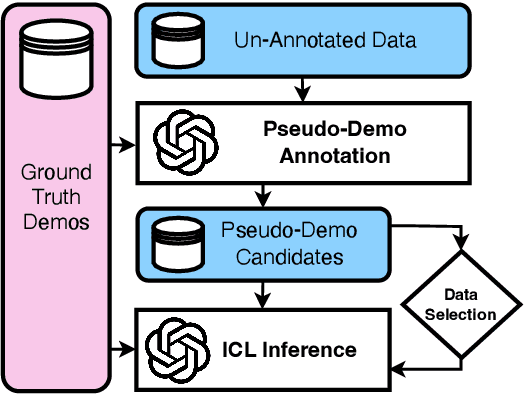
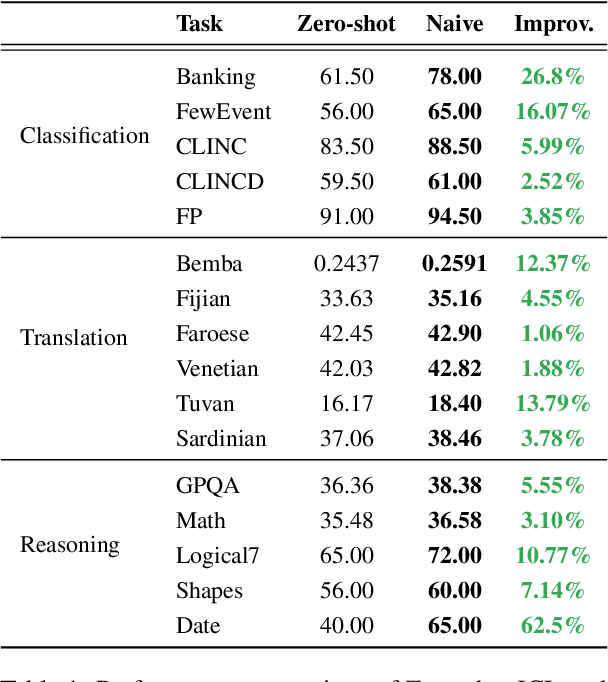
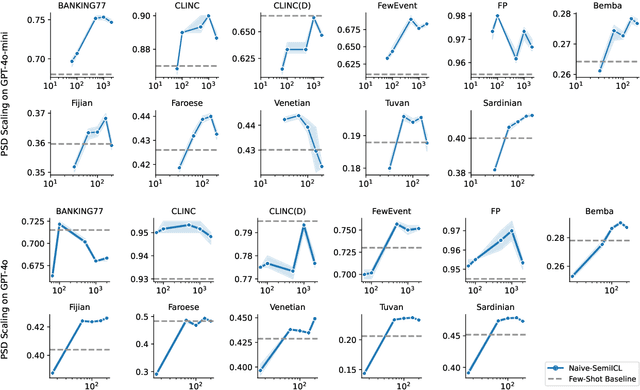

Abstract:Most existing work in data selection for In-Context Learning (ICL) has focused on constructing demonstrations from ground truth annotations, with limited attention given to selecting reliable self-generated annotations. In this work, we propose a three-step semi-supervised ICL framework: annotation generation, demonstration selection, and semi-supervised inference. Our baseline, Naive-SemiICL, which prompts select high-confidence self-generated demonstrations for ICL prompting, outperforms a 16-shot baseline by an average of 9.94% across 16 datasets. We further introduce IterPSD, an annotation approach that refines pseudo-demonstrations iteratively, achieving up to 6.8% additional gains in classification tasks. Lastly, we reveal a scaling law for semi-supervised ICL, where models achieve optimal performance with over 1,000 demonstrations.
TestNUC: Enhancing Test-Time Computing Approaches through Neighboring Unlabeled Data Consistency
Feb 26, 2025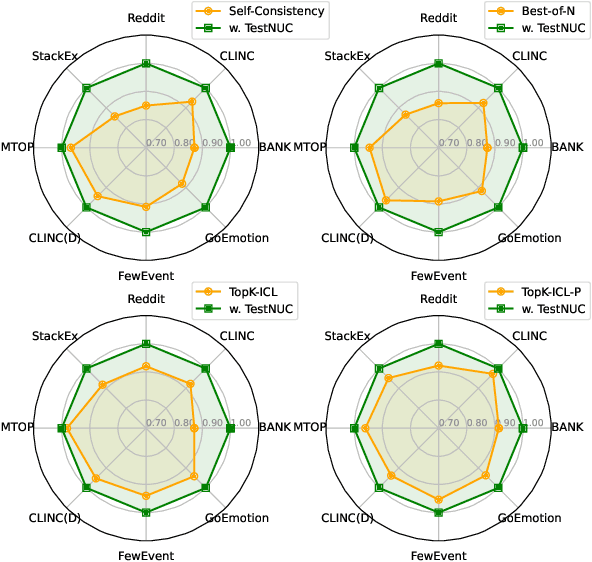
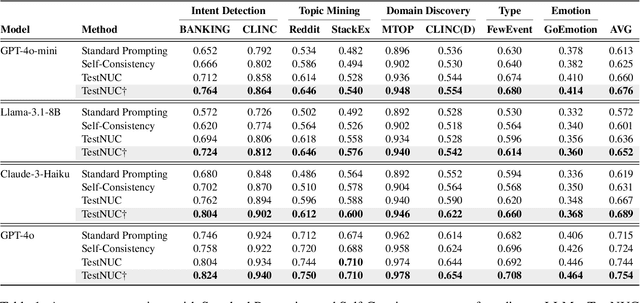
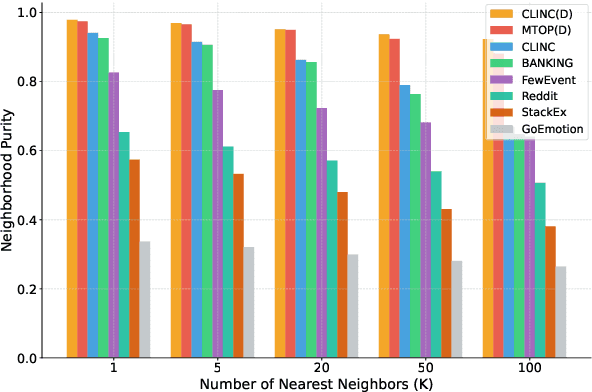
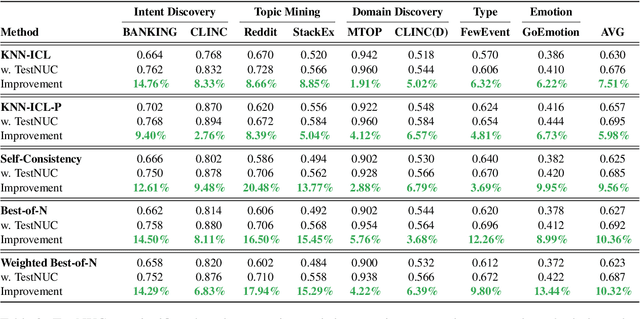
Abstract:Test-time computing approaches, which leverage additional computational resources during inference, have been proven effective in enhancing large language model performance. This work introduces a novel, linearly scaling approach, TestNUC, that improves test-time predictions by leveraging the local consistency of neighboring unlabeled data-it classifies an input instance by considering not only the model's prediction on that instance but also on neighboring unlabeled instances. We evaluate TestNUC across eight diverse datasets, spanning intent classification, topic mining, domain discovery, and emotion detection, demonstrating its consistent superiority over baseline methods such as standard prompting and self-consistency. Furthermore, TestNUC can be seamlessly integrated with existing test-time computing approaches, substantially boosting their performance. Our analysis reveals that TestNUC scales effectively with increasing amounts of unlabeled data and performs robustly across different embedding models, making it practical for real-world applications. Our code is available at https://github.com/HenryPengZou/TestNUC.
Multi-Agent Autonomous Driving Systems with Large Language Models: A Survey of Recent Advances
Feb 24, 2025Abstract:Autonomous Driving Systems (ADSs) are revolutionizing transportation by reducing human intervention, improving operational efficiency, and enhancing safety. Large Language Models (LLMs), known for their exceptional planning and reasoning capabilities, have been integrated into ADSs to assist with driving decision-making. However, LLM-based single-agent ADSs face three major challenges: limited perception, insufficient collaboration, and high computational demands. To address these issues, recent advancements in LLM-based multi-agent ADSs have focused on improving inter-agent communication and cooperation. This paper provides a frontier survey of LLM-based multi-agent ADSs. We begin with a background introduction to related concepts, followed by a categorization of existing LLM-based approaches based on different agent interaction modes. We then discuss agent-human interactions in scenarios where LLM-based agents engage with humans. Finally, we summarize key applications, datasets, and challenges in this field to support future research (https://anonymous.4open.science/r/LLM-based_Multi-agent_ADS-3A5C/README.md).
 Add to Chrome
Add to Chrome Add to Firefox
Add to Firefox Add to Edge
Add to Edge